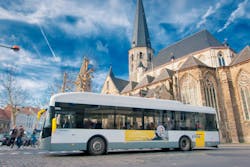With the focus of many agencies switching to electric buses, it is important for them to first consider which charging method would be most successful in their region. While some may view charging as a sort of inconvenience, Michael Austin of BYD Motors explained that agencies may be thinking of it in the wrong way. “Think about it this way, if I told you you’re going to charge your phone and you have to make it last all week. That’s ridiculous. I charge every time I go to work. I plug it into my car; you opportunity charge that to make it last a full week. You met technology half way,” said Austin.
Both methods have benefits and setbacks. In-route charging can be expensive or hard to place in larger cities, but allows for longer service without the bus returning to the facility. While overnight charging can be implausible for systems with longer routes, it has the benefit of cutting costs.
In-route charging
Microvast, which currently has several cities in China that operate buses with its batteries installed, predominantly aims to use fast charging.
Hanko Song VP of marketing at Microvast explained that they have charging areas at the end of a route, typically in parking lots, because it is hard to build charging stations in the large cities of China. The batteries take around 20 minutes to charge and Song said that during that time, drivers are able to take a break. “We are using charging guns to plug in. We use two charging guns, because one gun can only be limited by 250 amps and we’re charging about 500 amps.”
One agency in North America that has been looking toward turning electric is the Société de transport de Montréal (STM). François Chamberland, STM’s executive director of engineering, infrastructure and major projects, said that STM first began looking at electric buses in 2007. What they found was that there weren’t many fully electric buses available for them at that time. Another issue was how STM operates. They have their buses in route as long as possible — buses typically stay in service for 24 hours. At the end of the shift, the next driver is picked up along the route rather than returning to the facilities.
Using overnight charging just wasn't an option for STM. Chamberland said that they're currently running a trial called City Mobility with their supplier Nova Bus. "We have a grant from the government of $11.9 million to make a demonstration project with fast-charging buses. So we’ve chosen a route — it’s line number 36 here in Montreal — so it’s 10 kilometers long. We will get three fully electric buses that will arrive here for testing next week for the maintenance and the drivers," explained Chamberland. "Our goal is to demonstrate that they can do the job. Most demonstration projects that I've seen are small scale and after one year people say that it was a huge success and made less then 10,000 kilometers in a year. Our buses run 90,000 a year. So we want to put these buses in full service and show that they can work — with the road, the heat and the traffic that day-to-day operations need."
In-route charging does require as much power as possible, as Song said with the two charging guns, but there are also other options available.
Brendan Riley president of GreenPower Motor Company Inc. explained, “There are two different types of in-route charge. There is the contact type and there is the non-contact type. So we call it conductive or non-conductive. Basically you’ve got to plug it in or you don’t need to plug it in. There’s really all different results — I’ve been on these large vehicle charging groups and involved with them. There’s really trade-offs. For instance let’s take an overhead in-route charging system that uses a cantanary or overhead charging pantograph. In places where it gets really cold that can be a problem. In places where there is a lot of wildlife that can be a problem, I’ve head of cooked birds on some electric deployments.”
Overnight Charging
Overnight charging can benefit agencies in different ways — with overnight charging buses don't need to rely on making stops to get charges. This can prevent issues such as if there is a problem with the charging station or the bus, in the event that an issue did happen, it could cause a bottleneck of buses and slow service.
“If you have a battery that charges fully at night and it’s fully charged you can do your entire service all day without having to charge. That’s optimal,” said Austin. “You’ve got your service covered all day.”
Overnight charging can also be ideal for agencies to cut costs or electricity consumption.
“If you’ve got limited electricity supply, let’s say your infrastructure only permits for 480-100 amps of service, you’re really going to need overnight charging because you won’t get a very large charge at that level. If you’ve got a lot of power and its cheap and you can zap your buses, than in route charging is the way to go.” Riley said.
Song added that Micovast batteries that do slow charging are idea for smaller routes. "It's true that slow charging can provide lower costs," said Song, "but the battery life is not good."
Holding Charges in Extreme Climates
Many of the agencies that look into electric buses will not be in areas where they have perfect weather. Buses will have to adapt to heating in cooler temperate and cooling buses in extreme heat.
Chamberland said that the amount that temperatures drop in the winter was a big factor — and will continue to be in both the different charging options that they look at and what type of electric buses that they choose. “For us, heating is a big concern. If you use the electricity in the battery to heat up the bus then it won’t work. Heating is very consuming for the battery, so you really wouldn’t get the full range — about half the range — compared to the summer. It’s very hard to buy buses that would maybe give you 200 kilometers in the summer and maybe 100 in the winter. I don’t know how you can plan your service route with that kind of variable.”
Chamberland said that the flux of the buses opening their doors and letting in cold air in makes it even harder. “When you’re talking about an electric bus you have to look into more details.”
Before STM settled on using Nova Bus for their electric fleet they ran a trial with BYD.
“In the United States, anything south of New York and Minnesota, you can get away with electric heating,” explained Austin. “We did trials up in Montreal for a full winter. In all those launches we had a supplemental heater on board to help heat. We can certainly do it and draw all electric, but we are telling you it’s going to be a 20 to 30 percent range hit to electrify in a super frigid.”
In the end one winter temperatures was one of the reason that Montreal decided to go with the in-route charging, as well as including on-board heaters.
Riley said that GreenPower has seen similar results in cold weather causing the battery to be drained the fastest. “Our one double deckers, is running in the Greater Victoria Harbor Authority area. That is the coldest place that we have a bus operating. We don’t see more than a 10 to 15 percent hit with the heater running all the time. But I think that once we start deploying in areas like Montreal or Alberta, where we get really cold weather for long periods of time. Then I think that we have to revisit in-route charging to expand our ranges.”
Different Agencies, Different Needs
There are benefits and cons to both charging methods, in the end there isn't one method that is an overall ideal charging method for all agencies that are looking to turn toward electric. In-route charging can provide extended reach for agencies that have longer routes with more frequent service. Overnight charging can be more economical for smaller agencies, both through lower electricity costs as well as removing the cost of installing in-route charging stops.






